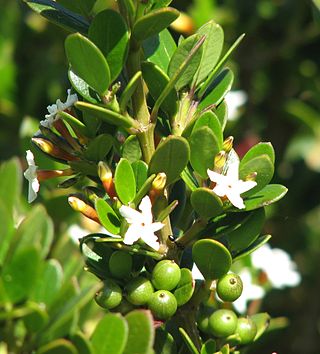
Alyxia is a genus of flowering plants in the family, Apocynaceae. It contains at present 106 species, but Alyxia stellata and A. tisserantii are very variable, might be cryptic species complexes, and are need of further study. It consists of shrubby, climbing or scrambling plants. This genus occurs in China, the Himalayas, Southeast Asia, Australia, New Caledonia and the Pacific Islands. There are 14 species in Australia, 21 in New Caledonia and 7 in the other Pacific Islands, including Hawaiʻi.

Acianthus, commonly known as mosquito orchids, is a genus of about twelve species of plants in the orchid family, Orchidaceae. Mosquito orchids are terrestrial herbs with a single, heart-shaped, usually ground-hugging leaf and one to many small, green, pinkish or purplish flowers on a fleshy stalk. They are found in New Caledonia, Australia and New Zealand.

Livistona is a genus of palms, the botanical family Arecaceae, native to southeastern and eastern Asia, Australasia, and the Horn of Africa. They are fan palms, the leaves with an armed petiole terminating in a rounded, costapalmate fan of numerous leaflets.

Myoporum is a genus of flowering plants in the figwort family, Scrophulariaceae. There are 30 species in the genus, eighteen of which are endemic to Australia although others are endemic to Pacific Islands, including New Zealand, and one is endemic to two Indian Ocean islands. They are shrubs or small trees with leaves that are arranged alternately and have white, occasionally pink flowers and a fruit that is a drupe.

Cordyline is a genus of about 24 species of woody monocotyledonous flowering plants in family Asparagaceae, subfamily Lomandroideae. The subfamily has previously been treated as a separate family Laxmanniaceae, or Lomandraceae. Other authors have placed the genus in the Agavaceae. Cordyline is native to the western Pacific Ocean region, from New Zealand, eastern Australia, southeastern Asia and Polynesia, with one species found in southeastern South America.

Lophostemon is a genus of 4 species of evergreen tree in the myrtle family Myrtaceae. All four species are native to Australia, with one extending to New Guinea. The genus was first described in 1830 but not widely recognized until the 1980s. All 4 species were previously included in the related genus Tristania.

Centrolepis is a genus of small herbaceous plants in the family Restionaceae known as thorn grass scales, with about 25 species native to Australia, New Zealand, New Guinea, and south-east Asia as far north as Hainan Dao. APG III system classifies this genus in the Centrolepidaceae family.
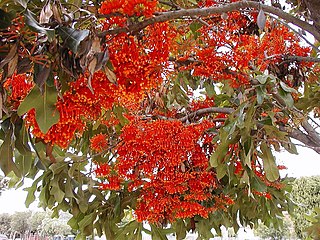
Stenocarpus is a genus of about 22 species of flowering plants in the family Proteaceae. They are trees or shrubs with variably-shaped leaves, zygomorphic, bisexual flowers, the floral tube opening on the lower side before separating into four parts, followed by fruit that is usually a narrow oblong or cylindrical follicle.

Spinifex is a genus of perennial coastal plants in the grass family.
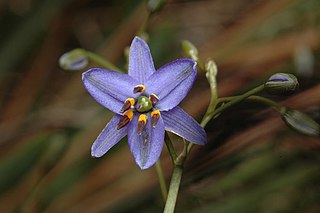
Dianella is a genus of about forty species of flowering plants in the monocot family Asphodelaceae, commonly known as flax lilies. Plants in this genus are tufted herbs with more or less linear leaves and bisexual flowers with three sepals more or less similar to three petals and a superior ovary, the fruit a berry. They occur in Africa, South-east Asia, the Pacific Islands, New Zealand and Australia.

Aneilema is a genus of monocotyledonous plants of approximately 60 species. The vast majority of the species are native to sub-Saharan Africa, but a few are found in Oceania and one, Aneilema brasiliense, is from South America. It is the third largest genus in the family Commelinaceae after Commelina and Tradescantia, and it is one of only six genera in the family to occur in both the Eastern Hemisphere and the Western Hemisphere.
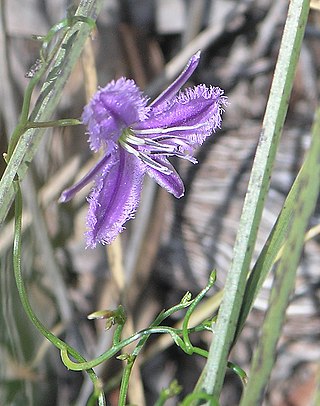
Thysanotus is a genus of perennial herbs in the family Asparagaceae, subfamily Lomandroideae. They are mostly native to Australia with 45 of the 50 known species occurring in Western Australia alone, although a few species range northward into New Guinea and Southeast Asia as far north as southern China.

Dipodium, commonly known as hyacinth orchids, is a genus of about forty species of orchids native to tropical, subtropical and temperate regions of south-east Asia, New Guinea, the Pacific Islands and Australia. It includes both terrestrial and climbing species, some with leaves and some leafless, but all with large, often colourful flowers on tall flowering stems. It is the only genus of its alliance, Dipodium.

Parsonsia is a genus of woody vines in the family Apocynaceae. Species occur throughout Indomalaya, Australasia and Melanesia.

Gahnia is a genus of sedges native to China, Southeast Asia, New Guinea, Australia, New Zealand and a number of Pacific Islands. The common name is due to the toothed margins. It often forms tussocks.

Utricularia uliginosa, the Asian bladderwort, is a small annual carnivorous plant that belongs to the genus Utricularia. It is native to Southeast Asia, Oceania, and Australia. U. uliginosa grows as a terrestrial or subaquatic plant in seasonally flooded shallow pools with sandy soils or on banks and among rocky stream beds at low altitudes. It was originally described by Martin Vahl in 1804.

Ficus fraseri, the white sandpaper fig or shiny sandpaper fig, is one of several fig species commonly known as sandpaper figs. It is native to the northern and eastern coasts of Australia, and to New Caledonia and Vanuatu. Other common names are "figwood" and "watery fig".
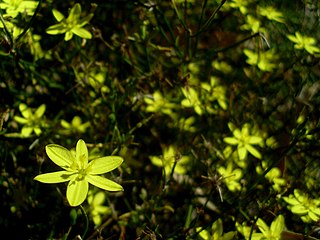
Tricoryne is a genus of perennial herbs in the family Asphodelaceae, subfamily Hemerocallidoideae. All species are native to Australia with two species extending to New Guinea; within Australia they occur in all 6 states and the Northern Territory.
- Tricoryne ancepsR.Br. - New Guinea, Queensland
- Tricoryne corynothecoidesKeighery - Western Australia
- Tricoryne elatiorR.Br. - Yellow Rush-lily - all 6 states plus Northern Territory
- Tricoryne humilisEndl. - Western Australia
- Tricoryne muricataBaker - Queensland
- Tricoryne platypteraRchb.f - New Guinea, Queensland
- Tricoryne simplexR.Br. - New South Wales
- Tricoryne tenellaR.Br. - Mallee Rush-lily - Western Australia, South Australia

Haemodorum is a genus of herbs in the family Haemodoraceae, first described as a genus in 1798 by James Edward Smiith. The genus is native to New Guinea and Australia. The type species is Haemodorum corymbosum Vahl, first described by Martin Vahl in 1805.

Leichhardtia is a genus of flowering plants in the dogbane family (Apocynaceae). It includes 85 species native to mainland Australia, Papuasia, New Caledonia, and Lord Howe Island.




















